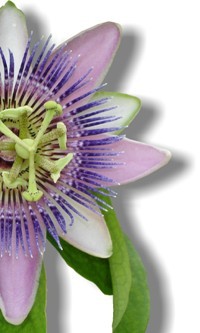Herbs - Medicinal Plants
Passiflora or Passion flower
Identification and origin of Passiflora

Scientific name: Passiflora incarnata
Other names: Passion flower, Passion vines.
The Passion flower is a plant with a permanent woody stem that can reach up to 10 m. The axillary pedicle grows to 8 cm and holds only a flower. Flowers are lined with a diameter of 5 to 9 cm. The five sepals are gray on the outside and white inside. Has a secondary corolla within the petals consisting of a 4-fiber ring arranged radially in the axis of the flower, which are white on the inside and purple in the outside. The ovary has 3 carpels and 3 styles, which end in a thick stigma. The 5 stamens are bound to the base.
Parts used: The whole or fractional plant and the aerial parts. The yellow pulp of the berries is edible. Some related species are also edible or have healing properties.
Passion Flower is originative from the southeastern part of North America untill Argentina and Brazil. It is grown as an ornamental plant in Europe.
Active ingredients of Passiflora or Passion Flower
The main active ingredients of Passiflora are:
Flavonoids: quercetol, kaempferol, apigenin, luteolin;
C-heteroside: vitexin, saponaroside, schaftoside, isoschaftoside, isovitexin, isoorientin.
Phytosterols: sitosterol, stigmasterol;
maltol;
Traces of cyanogenicheterosides: ginocardina.
Traces of essential oil with a composition little studied.
Dry drug must contain at least 0.3% (Pharmacopoeia Helvetica) or 0.4% (German Pharmacopoeia) of flavonoids expressed as hyperoside, or at least 0.8% of flavonoids in vitexin (E.S.C.O.P.)
The presence of harmaline, frequently indicated,
has not been properly confirmed.
>> continue reading about the Passiflora health benefits
References
- Anon, Phytotherapeutika: Nachgewiesene Wirkung, aber wirksame Stoffe meist nicht bekannt. In: DAZ 137(15): 1221- 1222. 1997.
- Aoyagi N et al., (1974) Chem Pharm Bull 22:1008.
- Assessment of the Hypnotic / Sedative Effects and Toxicity of Passiflora edulis Aqueous Extract in Rodents and Humans. Phytother Res 5:262-266.
- Bennati E, (1968), Boll Chim Farm 110:664.
- Bennati E, Fedeli E, (1968) Boll Chim Farm 107:716.
- Busse WW et al., (1984) J All Clin. Immunol. 73:801.
- Caesar W, Passionsblume. Kulturhistorische Aspekte einer Arzneipflanze. In: DAZ 137(8): 587-93. 1997.
- Hansel R, Pflanzliche Beruhigungsmittel Moglichkeiten und Grenzen der Selbstmedikation. In: DAZ 135(32), 2935-2943. 1995.
- Hansel R, Keller K, Rimpler H, Schneider G (Ed.), Hagers Handbuch der Pharmazeutischen Praxis, 5. Aufl., Bde 4 – 6 (Drogen), Springer Verlag Berlin, Heidelberg, New York, 1992- 1994.
- Leung AY, Encyclopedia of Common Natural Ingredients Used in Food Drugs and Cosmetics. John Wiley & Sons Inc. New York 1980.
- Loehdefink J, Kating H, (1974) Planta Med 25:101.
- Lutomski J, Malek B, (1975) Planta Med 27:381.
- Lutomski J, Wrocinski T, (1960) Bui Inst Ros Lee 6:176.
- Madaus G, Lehrbuch der Biologischen Arzneimittel, Bde 1-3,
- Maluf E, Barros HMT, Frochtengarten .-ML et al., (1991)
- Meier B, (1995) Passiflora incarnata - Portrait einer Arzneipflanze. Z Phytother 16:115-126.
- Meier B, (1995) Passiflorae herba - pharmazeutische Qualitat. Z Phytother 16:90-99.
- Middleton E, Drzewiecki G, (1984) Biochem Pharmacol 33:3333.
- Nachdruck, Georg Olms Verlag Hildesheim 1979.
- Poethke W, et al., (1970) Planta Med 18:303.

 Pharmacognosy´s topics - Medicinal plants
Pharmacognosy´s topics - Medicinal plants


























Write a comment